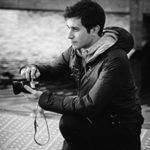The E-M5 between travel and portrait photography
I take photos to relax and decompress. I’m from a small Italian town one hour away from Venice. Like many other photographers these days, I learned photography by experimenting with my camera and reading online. Over the years, most of my work had focused on landscape and travel photography, where more often than not I strive for vibrant colors and strong lines. I like to get close and zoom in, and I’m a big fan of panoramas. For my day job, I work as a researcher in biotechnology, and being able to put my mind to an engaging hobby has been a great way to relieve stress.



My first camera was an Olympus OM-D E-M5. I loved the small size and weight, the large selection of small high-quality lenses at reasonable prices, and how good it looked. In hindsight, there are two main reasons I love the Olympus system. First, if you go online and read about the Micro Four Thirds system, you will read about its limited ability to achieve shallow depth of field.
Personally, I think this is a feature, not a bug. When I’m taking travel photos in low light conditions (which is very often), I can use a wide aperture to let in more light while still keeping everything in focus. This is critical if you like to get close to your subject. Second, I couldn’t use a camera without a stabilized sensor.
For a given shutter speed, it lets the camera keep the ISO a few stops lower and produce sharp images. Combined with the ability to use a large aperture in most situations, this feature keeps sensor noise lower and requires me to use a tripod far less often.



I recently upgraded to an Olympus OM-D E-M5 Mark II. When I travel, I use two zoom lenses: the Olympus M.Zuiko Digital ED 12-40mm f/2.8 PRO and Olympus M.Zuiko Digital ED 40-150mm f/4.0-5.6 R. The latter is especially useful and one of my favorites. Even though it’s by far the cheapest lens in my kit, it’s small, light, and gives great results.
Since I moved to the United States to pursue a PhD in Molecular Engineering, my free time has decreased significantly. Traveling to new exciting places has become harder and harder, so I decided to begin focusing on portrait photography. This big change, challenging and exciting at the same time, led me to learn many new skills and has been a ton of fun. I shoot with a Panasonic Lumix G Leica DG Summilux 25mm f/1.4 ASPH lens and, more often, an Olympus M.Zuiko Digital ED 45mm f/1.8.
My setup is fairly simple: I use a white wall or black paper for the background and a single flash with a wireless trigger for lighting. I control the main light with an octabox or a large reflective umbrella, and often add a large reflector for fill. For post-processing, I use Adobe Lightroom Classic and Photoshop for most of my workflow and then add the finishing touches in ON1 Photo RAW 2019.



One of the biggest challenges for me is to keep a consistent style and look in my photos. To make this easier, I developed a standard shooting and processing workflows and periodically go back and re-edit old photos.
For instance, because I like vibrant colors that pop, so I process nearly all of my travel photos using the same workflow that involve increasing vibrance, raising the mids in the tone curve and aggressive sharpening.
Whenever I select photos from a shoot to edit for the first time, these rarely end up being the ones I use. Looking at my work with fresh eyes helps me be more objective in selecting the best shots and best edits.



To conclude, I’d like to share the best advice I’ve been given by a photographer friend: avoid sharing too many photos from the same session (my rule of thumb: three). Curate your work and post only your best shots.



Jason Fontana is a PhD graduate in Molecular Engineering from University of Washington in Seattle, USA.





